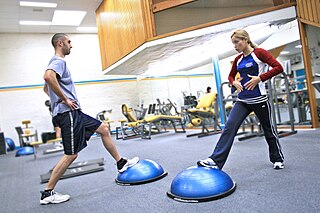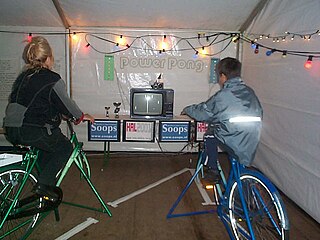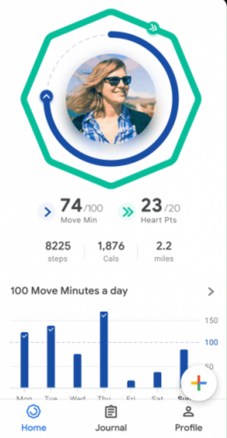
A personal trainer is an individual who creates and delivers safe and effective exercise programs for healthy individuals and groups, or those with medical clearance to exercise. They motivate clients by collaborating to set goals, providing meaningful feedback, and by being a reliable source for accountability. Trainers also conduct a variety of assessments beginning with a preparticipation health-screening and may also include assessments of posture and movement, flexibility, balance, core function, cardio-respiratory fitness, muscular fitness, body composition, and skill-related parameters to observe and gather relevant information needed to develop an effective exercise program and support client goal attainment.

Physical education, or personal education, often abbreviated to Phys Ed. or P.E., is a subject taught in schools around the world. It is usually taught during primary and secondary education and encourages psychomotor learning by using a play and movement exploration setting to promote health and physical fitness. Activities in P.E. include football, netball, hockey, rounders, cricket, four square, racing, and numerous other children's games. Physical education also teaches nutrition, healthy habits, and individuality of needs.

Aerobic exercise is physical exercise of low to high intensity that depends primarily on the aerobic energy-generating process. "Aerobic" is defined as "relating to, involving, or requiring oxygen", and refers to the use of oxygen to meet energy demands during exercise via aerobic metabolism adequately. Aerobic exercise is performed by repeating sequences of light-to-moderate intensity activities for extended periods of time. Examples of cardiovascular or aerobic exercise are medium- to long-distance running or jogging, swimming, cycling, stair climbing and walking.

Physical fitness is a state of health and well-being and, more specifically, the ability to perform aspects of sports, occupations and daily activities. Physical fitness is generally achieved through proper nutrition, moderate-vigorous physical exercise, and sufficient rest along with a formal recovery plan.
Rogers Wireless Inc. is a Canadian wireless telephone company headquartered in Toronto, providing service nationally throughout Canada. It is a wholly owned subsidiary of Rogers Communications. The company had revenues of just under $15.1 billion in 2018. Rogers Wireless is the largest wireless carrier in Canada, with 10.8 million subscribers as of Q3 2020.

The President's Council on Sports, Fitness and Nutrition (PCSFN) is an American government organization that aims to promote "programs and initiatives that motivate people of all ages, backgrounds, and abilities to lead active, healthy lives." It is part of the Office of Public Health and Science, an agency of the United States Department of Health and Human Services. Prior to June 2010, it was called the President's Council on Physical Fitness and Sports.
Sport Canada is a branch of the Department of Canadian Heritage that develops federal sport policy in Canada, provides funding programs in support of sport, and administers special projects related to sport. Its mission "to enhance opportunities for all Canadians to participate and excel in sport."

Fitness game, exergame, and gamercise are terms used for video games that are also a form of exercise. Fitness games rely on technology that tracks body movement or reaction. The genre has been used to challenge the stereotype of gaming as a sedentary activity, and promoting an active lifestyle. Fitness games are seen as evolving from technology aimed at making exercise more fun.
Philippe de Gaspé Beaubien is a Canadian media proprietor, who was chairman and CEO of Telemedia. He founded the company in 1968, and went on to acquire a number of radio stations in Quebec and Ontario, and launched magazines such as Canadian Living, Harrowsmith and the Canadian editions of ELLE and TV Guide. In 1990, together with his wife Nan-b de Gaspé Beaubien, he launched The Business Families Foundation (BFF), a non-profit charitable organization established in Canada to help business families in Canada and abroad.
Health promotion is, as stated in the 1986 World Health Organization (WHO) Ottawa Charter for Health Promotion, the "process of enabling people to increase control over, and to improve their health."

Active living is a lifestyle that integrates physical activity into everyday routines, such as walking to the store or biking to work. Active living is not a formalized exercise program or routine, but instead means to incorporate physical activity, which is defined as any form of movement, into everyday life. Active living brings together urban planners, architects, transportation engineers, public health professionals, activists and other professionals to build places that encourage active living and physical activity. One example includes efforts to build sidewalks, crosswalks, pedestrian crossing signals, and other ways for children to walk safely to and from school, as seen in the Safe Routes to School program. Recreational opportunities close to the home or workplace, walking trails, and bike lanes for transportation also contribute to a more active lifestyle. Active living includes any physical activity or recreation activity and contributes to a healthier lifestyle. Furthermore, active living addresses health concerns, such as obesity and chronic disease, by helping people have a physically active lifestyle. Communities that support active living gain health benefits, economic advantages, and improved quality of life.
General fitness training works towards broad goals of overall health and well-being, rather than narrow goals of sport competition, larger muscles or concerns over appearance. A regular moderate workout regimen and healthy diet can improve general appearance markers of good health such as muscle tone, healthy skin, hair and nails, while preventing age or lifestyle-related reductions in health and the series of heart and organ failures that accompany inactivity and poor diet.

Lack of physical education is the inadequacy of the provision and effectiveness of exercise and physical activity within modern education.
Workplace health promotion is the combined efforts of employers, employees, and society to improve the mental and physical health and well-being of people at work. The term workplace health promotion denotes a comprehensive analysis and design of human and organizational work levels with the strategic aim of developing and improving health resources in an enterprise. The World Health Organization has prioritized the workplace as a setting for health promotion because of the large potential audience and influence on all spheres of a person's life. The Luxembourg Declaration provides that health and well-being of employees at work can be achieved through a combination of:

An activity tracker, also known as a fitness tracker, is a device or application for monitoring and tracking fitness-related metrics such as distance walked or run, calorie consumption, and in some cases heartbeat. It is a type of wearable computer. The term is now primarily used for smartwatches that are synced, in many cases wirelessly, to a computer or smartphone for long-term data tracking. There are also independent mobile and Facebook apps. Some evidence has found that the use of these type of devices results in less weight loss rather than more. Sleep tracker devices have a tendency to underdetect wakefulness.
The Canada Fitness Award Program was a national fitness test and evaluation program operated by the Government of Canada department Health and Welfare Canada from 1970 to 1992. It was a successor to the Centennial Athletic Awards Program, and was replaced by the Active Living Challenge program.

Google Fit is a health-tracking platform developed by Google for the Android operating system, Wear OS, and iOS. It is a single set of APIs that blends data from multiple apps and devices. Google Fit uses sensors in a user's activity tracker or mobile device to record physical fitness activities, which are measured against the user's fitness goals to provide a comprehensive view of their fitness.

Fitness culture is a sociocultural phenomenon surrounding exercise and physical fitness. It is usually associated with gym culture, as doing physical exercises in locations such as gyms, wellness centres and health clubs is a popular activity. An international survey found that more than 27% of world total adult population attends fitness centres, and that 61% of regular exercisers are currently doing "gym-type" activities. Getting and maintaining physical fitness has been shown to benefit individuals' inner and outer health. Fitness culture has become highly promoted through modern technology and from the rising popularity of social media platforms.
Kelly D. Murumets is a Canadian business executive who served as the President and Chief Executive Officer (CEO) of Tennis Canada from 2014 to 2017. She was also the President and CEO of ParticipACTION, a non-profit organization which promotes healthy living and physical fitness, from 2007 to 2014.

Hal Johnson and Joanne McLeod are Canadian television hosts and former international-level athletes. They are best known for their television segments called BodyBreak, which have been in intermittent production since 1988. The program is considered a cult classic among Canadian pop culture.












